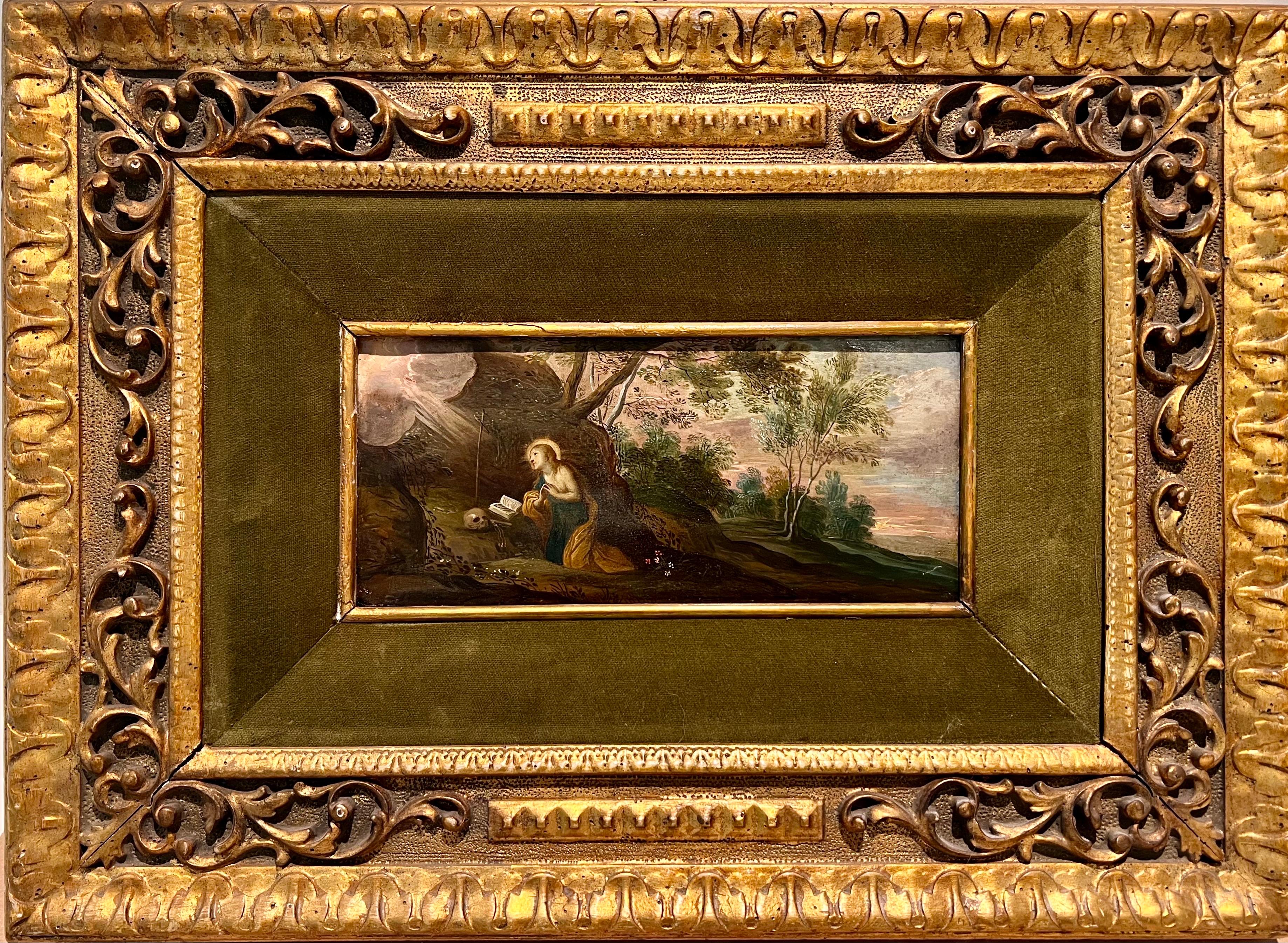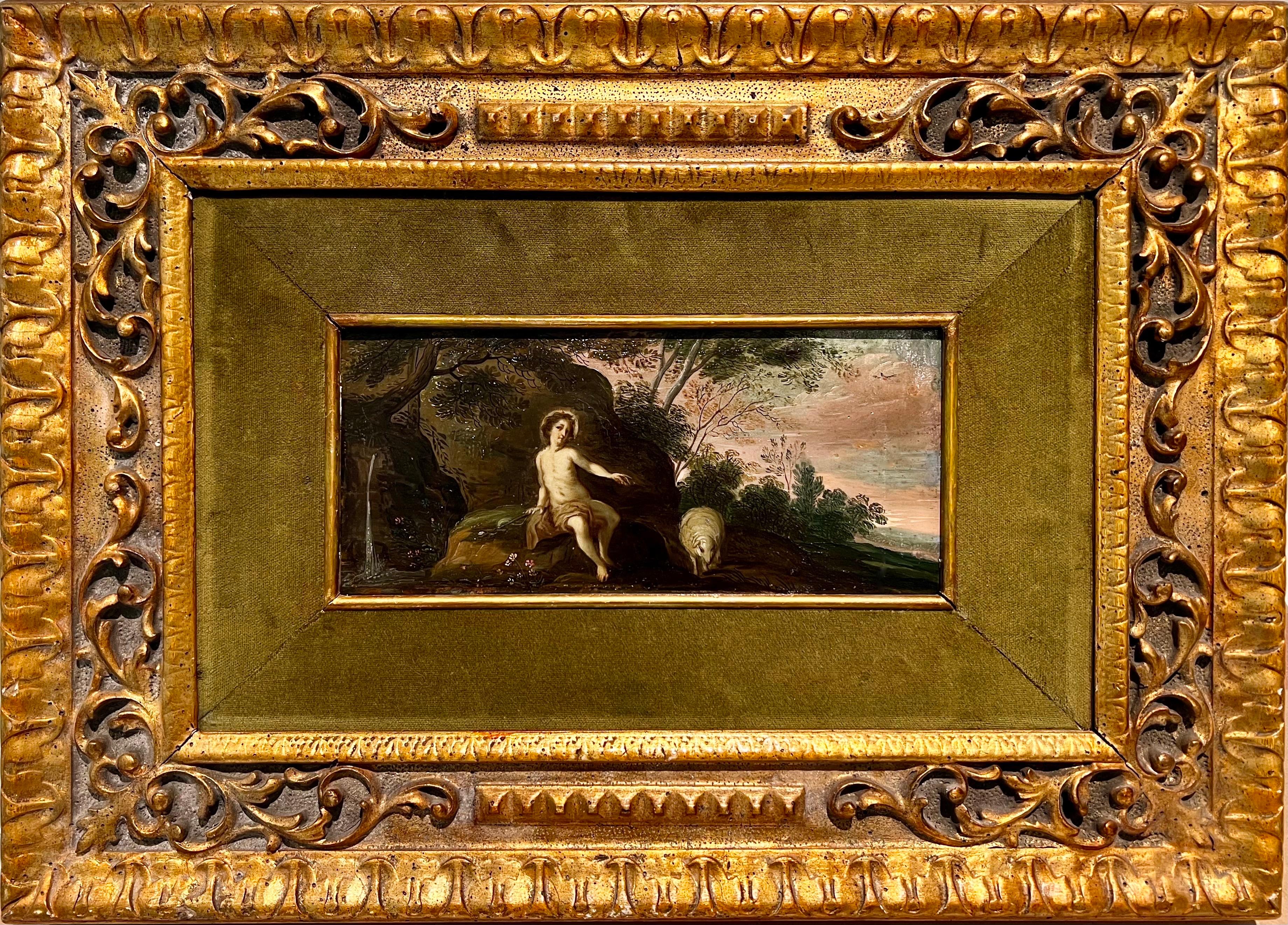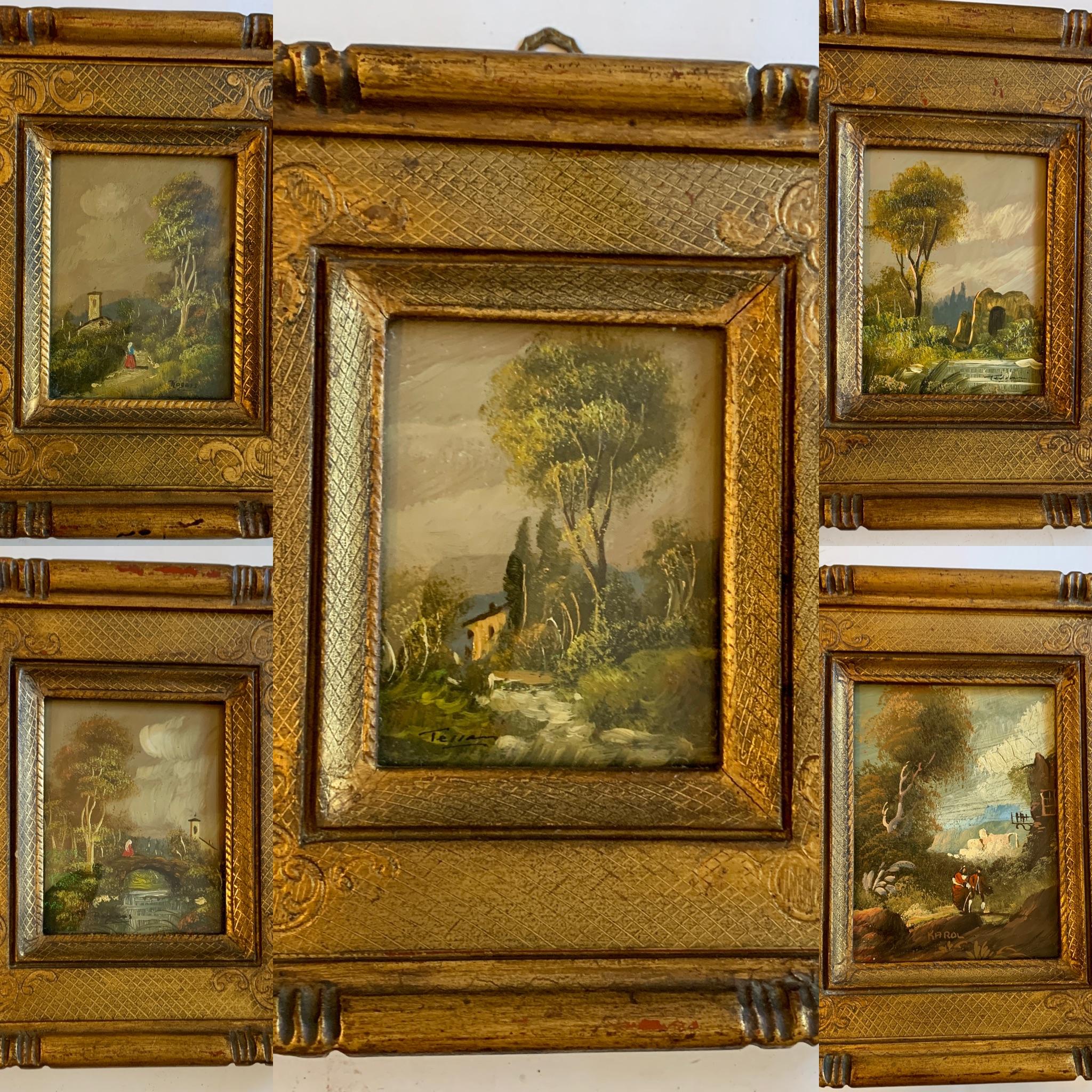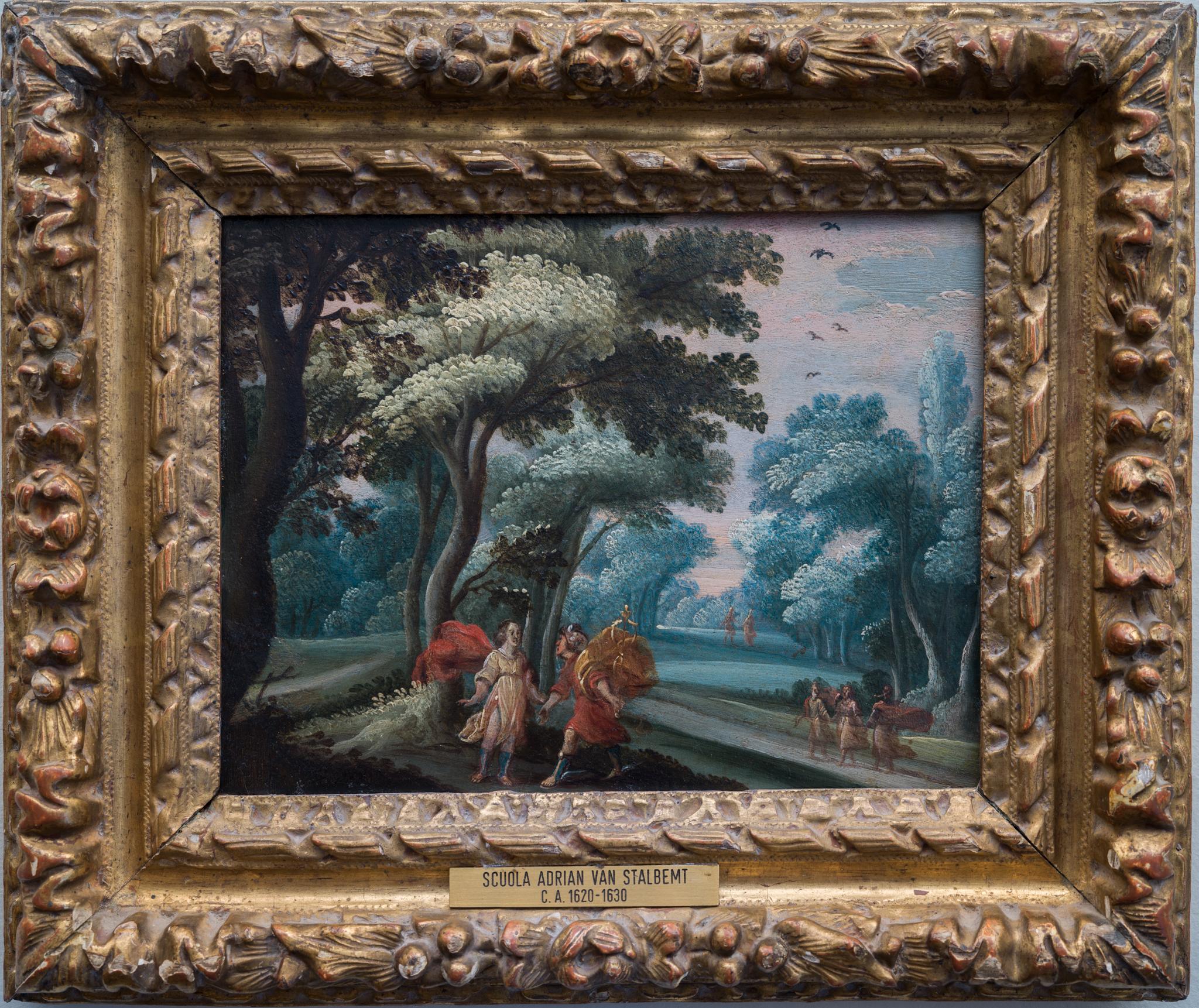Items Similar to Allegory of Abundance
Want more images or videos?
Request additional images or videos from the seller
1 of 4
Jan Brueghel the YoungerAllegory of Abundancec. 1630
c. 1630
About the Item
Painted in collaboration with Hendrick van Balen (Antwerp, 1575 – 1632).
Provenance: Private Collection, Uruguay, since the 1930s.
The eldest son of Jan Breughel the Elder, Jan the Younger trained with his father in Antwerp before setting off for Italy with his childhood friend Anthony van Dyck around 1620. He returned in 1625, becoming a member of the Antwerp painter’s guild (he would become Dean in 1630) and taking over his recently deceased father’s active and successful studio. While he remained active in his native city throughout his long career, his clients came from across Europe and included the Austrian and French courts. The subject matter of his paintings was varied, although he is best known for his idealized landscapes which might feature villages, as well as his allegories and mythological scenes, often made in collaboration with the specialists in figure painting, such as in the present example. Brueghel’s landscape—characterized by a meticulous handling of receding space and populated with beautifully-observed animals, fruits, flowers, and other natural elements—here serves as the setting for a meeting of gods and goddesses accompanied by a satyr, nymphs, and winged putti.
This work is a newly discovered and version of a composition treated on at least two other occasions by Brueghel. The best known is that in National Gallery in Prague with figures by Hendrick van Balen (Fig. 1), while another panel of similar dimensions with figures by Ambrosius Francken the Younger is in a private collection in New York (Fig. 2). Our painting is slightly larger than those two and is distinguished both by its copper support and more expansive treatment of the trees and sky across the top of the painting. As is typical of Jan Brueghel the Younger’s collaborative efforts, van Balen was responsible for the principal figures, while Brueghel painted the landscape, still-life elements, and staffage.
The subject of the work has been variously titled throughout the scholarly literature. For Gustav Glück it was an Allegory of Autumn; Klaus Ertz termed it an Allegory of Abundance; and Bettina Werche catalogued it as Bacchus, Venus, and Ceres. It may properly be considered all three. The harvest deities of Bacchus and Ceres flank the goddess of love Venus and well-illustrate the motto Sine Cerere et Baccho friget Venus (“Without Bacchus and Ceres, Venus grows cold”)—a quotation from the Roman dramatist Terence, suggesting that love disappears without the stimulus of wine and food. As Bacchus, the wine god, and Ceres, the goddess of agriculture, are associated with the bounty of the autumn harvest, their presence—in the context of the richness of the vegetation, produce, fruits, and flowers depicted—make the painting both an allegory of the season, and, more broadly, one of Abundance.
Brueghel was a master of creating a microcosm of the world—here encompassing both the earthly and the godly—in the limited space of a cabinet picture. The composition is created from two divergent diagonals that begin in the center foreground and receipt to the outer edges of the painting, pointing towards two distant landscape views punctuated by a pink and blue tinged sky. The mass of dense trees executed in earthy brown and green hues in the center of the middle-ground serves as a backdrop to the figures in the foregrounds and offsets the rich colors of their garments. These sophisticated compositional devises serve to create an attractive image that presents engaging passages of visual interest throughout.
Dr. Klaus Ertz has confirmed Jan Brueghel the Younger authorship of the painting, with figures by Hendrick van Balen, upon firsthand inspection (certificate of 7 April 2022). Ertz dates the work ca. 1630, shortly after Breughel’s return from Italy in 1625.
- Creator:Jan Brueghel the Younger (1601 - 1678, Flemish)
- Creation Year:c. 1630
- Dimensions:Height: 29.88 in (75.9 cm)Width: 41.25 in (104.78 cm)
- Medium:
- Movement & Style:
- Period:
- Condition:
- Gallery Location:New York, NY
- Reference Number:1stDibs: LU10210793482

About the Seller
5.0
Recognized Seller
These prestigious sellers are industry leaders and represent the highest echelon for item quality and design.
Established in 1997
1stDibs seller since 2012
17 sales on 1stDibs
Typical response time: 11 hours
- ShippingRetrieving quote...Ships From: New York, NY
- Return PolicyThis item cannot be returned.
More From This SellerView All
- View of St. John’s Cathedral, AntiguaLocated in New York, NYProvenance: Robert Hollberton, Antigua, ca. 1841 Private Collection, New York The present painting depicts Old St. John’s Cathedral on the island of Antigua. The church was erected in the 1720s on the designs of the architect Robert Cullen. It measured 130 feet by 50 feet with north and south porches 23 x 20 ½ feet. The tower, 50 feet high with its cupola, was added in 1789. The church was elevated to the status of a cathedral, but disaster struck in the form of an earthquake that destroyed the building on 8 February 1843. A memorandum of that date relates the event: “On Wednesday, 8th February, 1843, this island was visited by a most terrific and destructive earthquake. At twenty minutes before eleven o’clock in the forenoon, while the bell was ringing for prayers, and the venerable Robert Holberton was in the vestry-room, awaiting the arrival of persons to have their marriage solemnized, before the commencement of the morning service, the whole edifice, from one end to the other, was suddenly and violently agitated. Every one within the church, after the first shock, was compelled to escape for his life. The tower was rent from the top to the bottom; the north dial of the clock precipitated to the ground with a dreadful crash; the east parapet wall of the tower thrown upon the roof of the church; almost the whole of the north-west wall by the north gallery fell out in a mass; the north-east wall was protruded beyond the perpendicular; the altar-piece, the public monument erected to the memory of lord Lavington, and the private monuments, hearing the names of Kelsick, Warner, Otley, and Atkinson, fell down piecemeal inside; a large portion of the top of the east wall fell, and the whole of the south-east wall was precipitated into the churchyard, carrying along with it two of the cast-iron windows, while the other six remained projecting from the walls in which they had been originally inserted; a large pile of heavy cut stones and masses of brick fell down at the south and at the north doors; seven of the large frontpipes of the organ were thrown out by the violence of the shock, and many of the metal and wooden pipes within displaced; the massive basin of the font was tossed from the pedestal on which it rested, and pitched upon the pavement beneath uninjured. Thus, within the space of three minutes, this church was reduced to a pile of crumbling ruins; the walls that were left standing being rent in every part, the main roof only remaining sound, being supported by the hard wood pillars.” The entrance from the southern side into the cathedral, which was erected in 1789, included two imposing statues, one of Saint John the Divine and the other of Saint John the Baptist in flowing robes. It is said that these statues were confiscated by the British Navy from the French ship HMS Temple in Martinique waters in 1756 during the Seven Years’ War and moved to the church. The statues are still in situ and can be seen today, much as they appeared in Bisbee’s painting, but with the new cathedral in the background (Fig. 1). Little is known of the career of Ezra Bisbee. He was born in Sag Harbor, New York in 1808 and appears to have had a career as a political cartoonist and a printmaker. His handsome Portrait of President Andrew Jackson is dated 1833, and several political lithographs...Category
19th Century Old Masters Landscape Paintings
MaterialsOil, Canvas
- A WolfLocated in New York, NYProvenance: The Marchesi Strozzi, Palazzo Strozzi, Florence Sale, Christie’s, London, May 20, 1993, lot 315, as by Carl Borromaus Andreas Ruthart...Category
17th Century Old Masters Animal Paintings
MaterialsPaper, Canvas, Oil
- Two Scenes of Diana and Actaeon (a pair)By Giovanni Battista ViolaLocated in New York, NYProvenance: Robert L. and Bertina Suida Manning, New York, until 1996 Private Collection, USA Giovanni Battista Viola was born in Bologna a...Category
17th Century Baroque Landscape Paintings
MaterialsCopper
- Ezekiel in the Valley of Dry BonesBy Philip Burne-JonesLocated in New York, NYProvenance: Christie’s, London, 3 March 1922, lot 46 (with The Tower of Babel); James Nicoll Private Collection Sotheby’s, London, 29 March 1983, lot 157 Private Collection, New Yo...Category
Late 19th Century Victorian Figurative Paintings
MaterialsOil, Canvas
- Still Life with Squash, Gourds, Stoneware, and a Basket with Fruit and CheeseLocated in New York, NYProvenance: Selma Herringman, New York, ca. 1955-2013; thence by descent to: Private Collection, New York, 2013-2020 This seventeenth century Spanish still-life of a laden table, known as a bodegón, stands out for its dramatic lighting and for the detailed description of each object. The artist’s confident use of chiaroscuro enables the sliced-open squash in the left foreground to appear as if emerging out of the darkness and projecting towards the viewer. The light source emanates from the upper left, illuminating the array, and its strength is made apparent by the reflections on the pitcher, pot, and the fruit in the basket. Visible brush strokes accentuate the vegetables’ rough surfaces and delicate interiors. Although the painter of this striking work remains unknown, it is a characteristic example of the pioneering Spanish still-lifes of the baroque period, which brought inanimate objects alive on canvas. In our painting, the knife and the large yellow squash boldly protrude off the table. Balancing objects on the edge of a table was a clever way for still-life painters to emphasize the three-dimensionality of the objects depicted, as well a way to lend a sense of drama to an otherwise static image. The knife here teeters on the edge, appearing as if it might fall off the table and out of the painting at any moment. The shape and consistency of the squash at left is brilliantly conveyed through the light brush strokes that define the vegetable’s fleshy and feathery interior. The smaller gourds—gathered together in a pile—are shrouded partly in darkness and stand out for their rugged, bumpy exterior. The stoneware has a brassy glaze, and the earthy tones of the vessels are carefully modulated by their interaction with the light and shadow that falls across them. The artist has cleverly arranged the still-life in a V-shaped composition, with a triangular slice of cheese standing upright, serving as its pinnacle. Independent still-lifes only became an important pictorial genre in the first years of the seventeenth century. In Italy, and particularly through the revolutionary works of Caravaggio, painted objects became carriers of meaning, and their depiction and arrangement the province of serious artistic scrutiny. Caravaggio famously asserted that it was equally difficult to paint a still-life as it was to paint figures, and the elevation of this new art form would have profound consequences to the present day. In Spain Juan Sanchez Cotan...Category
17th Century Old Masters Still-life Paintings
MaterialsCanvas, Oil
- Esther in the Women's House of AhasuerusBy Artus WolfortLocated in New York, NYBorn in Antwerp, Artus Wolffordt received his training in Dordrecht where he became a master in 1603 at the age of twenty-two. He returned to his native city in 1615 and initially worked as an assistant to Otto van Veen...Category
17th Century Old Masters Paintings
MaterialsPanel, Oil
You May Also Like
- 18th century Old Master oil painting - Travellers at rest in a sunset landscapeLocated in Antwerp, BE18th century old master painting depicting a peaceful countryside scenery at sunset with a fortified town visible in the distance attributed to Franz Paula de Ferg In the present je...Category
18th Century Old Masters Landscape Paintings
MaterialsCopper
- 17th century religious old master oil - Penitent Magdalene in a landscapeLocated in Antwerp, BE17th century oil on copper - Penitent Magdalene in a landscape The very finely and delicately painting depicts Mary Magdalene in a vast landscape, with a vibrant sunset colouring th...Category
17th Century Old Masters Figurative Paintings
MaterialsCopper
- 17th century religious old master oil - St. John the Baptist in a landscapeLocated in Antwerp, BE17th century oil on copper - St. John the Baptist in a landscape with the Lamb The very finely and delicately painting depicts St. John in a vast landscape, with a vibrant sunset co...Category
17th Century Old Masters Figurative Paintings
MaterialsCopper
- Five mid 20th century Italian oil landscapes with figures, castles, ChurchsLocated in Woodbury, CTA very interesting set of five mid-20th-century Italian oils on copper. All five are classical landscape subjects and are signed Roger, though we don't know which artist with the n...Category
1950s Old Masters Landscape Paintings
MaterialsCopper
- A 17th Century Mythological SceneLocated in Stockholm, SEThis small yet captivating painting, crafted on a copper plate, dates back to the mid-1600s and was created by a Flemish artist. Subject Matter: The central figure in the artwork is Mercury, easily identified by his symbolic attributes like winged sandals, petasus, and caduceus. Beside him is a likely female figure, characterized by her attire and absence of weaponry. The depicted scene could represent two mythological tales: Mercury and Calypso: This interpretation suggests the artwork shows the moment Zeus sends Mercury to Calypso's island, Ogygia. Mercury is there to order Calypso to release Ulysses, whom she saved from a shipwreck but kept captive. The lush, wooded background and the three distant figures could hint at Ulysses' farewell to Calypso. Mercury and Herses: Another interpretation could be a scene from the love story of Mercury and Herses. The background figures might symbolize the sisters returning from a procession, while the forefront could be the initial meeting between Mercury and the most beautiful sister, Erse. Artistic Inspiration: The painting's landscape and setting are heavily influenced by the early 17th century Northern European art trends, especially the works of Jan Brueghel the Elder. However, the artwork stands apart with its unique luminescence in detailing and a distinctive approach to depicting figures. While the exact origin and artist remain somewhat mysterious, the style and treatment of light hint towards works close to Josse de Momper...Category
Mid-17th Century Old Masters Figurative Paintings
MaterialsCopper
- A Pair of Forest Landscapes, Philipp H. Brinckmann, 1709 – 1761, Old MasterLocated in Bruges, BEA Pair of Forest Landscapes with River and Boat in the Foreground Brinckmann Philipp Hieronymus Spire 1709 – 1761 Manheim Old Master Signature: Signed "Ph. Brinckm" bottom lower lef...Category
18th Century Old Masters Landscape Paintings
MaterialsCopper
Recently Viewed
View AllMore Ways To Browse
Antique Receipt
Antique Green Picture Frames
Wine Harvest
Old Black Painted Cabinet
Antique Food Cabinet
Winged Goddess
Italian Oil Painting Wine
Italian Cabinet Landscape
Van Dyck Oil
Black Wine Cabinet
Nymph Oil Painting
7 Gods
French 17th C Paintings
Antique Copper Cabinet Handles
Putti Oil
Still Life Flowers Wine
Brueghel Painting
Oil On Copper Painting 17th Century





